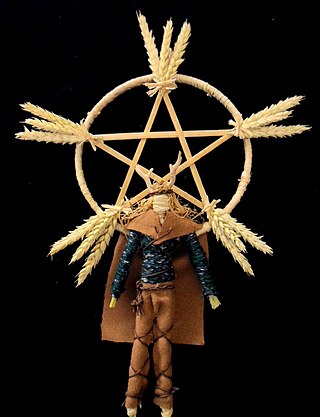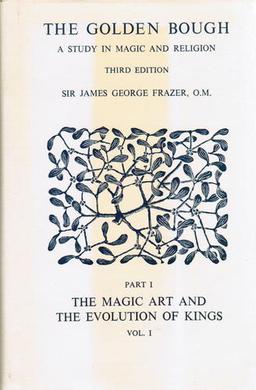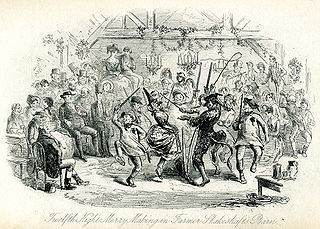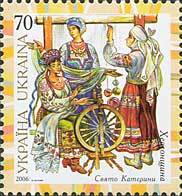
Bealtaine is the Gaelic May Day festival. It is traditionally held on 1 May, or about midway between the spring equinox and summer solstice in the northern hemisphere. The festival name is synonymous with the month marking the start of summer in Gaelic Ireland. Historically, it was widely observed throughout Ireland, Scotland, and the Isle of Man. In Irish the name for the festival day is Lá Bealtaine while the month of May is Mí na Bealtaine, in Scottish Gaelic Latha Bealltainn, and in Manx Gaelic Laa Boaltinn/Boaldyn. Beltane is one of the four main Gaelic seasonal festivals—along with Samhain, Imbolc, and Lughnasadh—and is similar to the Welsh Calan Mai.

Halloween or Hallowe'en is a celebration observed in many countries on 31 October, the eve of the Western Christian feast of All Saints' Day. It begins the observance of Allhallowtide, the time in the liturgical year dedicated to remembering the dead, including saints (hallows), martyrs, and all the faithful departed.

Imbolc or Imbolg, also called Saint Brigid's Day, is a Gaelic traditional festival. It marks the beginning of spring, and for Christians, it is the feast day of Saint Brigid, Ireland's patroness saint. It is held on 1 February, which is about halfway between the winter solstice and the spring equinox. Historically, its traditions were widely observed throughout Ireland, Scotland and the Isle of Man. Imbolc is one of the four Gaelic seasonal festivals, along with: Beltane, Lughnasadh and Samhain.

Samhain is a Gaelic festival on 1 November marking the end of the harvest season and beginning of winter or "darker half" of the year. Celebrations begin on the evening of 31 October, since the Celtic day began and ended at sunset. This is about halfway between the autumnal equinox and winter solstice. It is one of the four Gaelic seasonal festivals along with Imbolc, Beltaine, and Lughnasa. Historically it was widely observed throughout Ireland, Scotland, Galicia, and the Isle of Man. A similar festival was held by the Brittonic Celtic people, called Calan Gaeaf in Wales, Kalan Gwav in Cornwall, and Kalan Goañv in Brittany.

Trick-or-treating is a traditional Halloween custom for children and adults in some countries. During the evening of Halloween, on October 31, people in costumes travel from house to house, asking for treats with the phrase "trick or treat". The "treat" is some form of confectionery, usually candy/sweets, although in some cultures money is given instead. The "trick" refers to a threat, usually idle, to perform mischief on the resident(s) or their property if no treat is given. Some people signal that they are willing to hand out treats by putting up Halloween decorations outside their doors; houses may also leave their porch lights on as a universal indicator that they have candy; some simply leave treats available on their porches for the children to take freely, on the honor system.

Lughnasadh, Lughnasa or Lúnasa is a Gaelic festival marking the beginning of the harvest season, and an official holiday in Ireland. Historically, it was widely observed throughout Ireland, Scotland and the Isle of Man. Traditionally it is held on 1 August, or about halfway between the summer solstice and autumn equinox. In recent centuries some of the celebrations have shifted to the Sunday nearest this date. Lughnasadh is one of the four Gaelic seasonal festivals, along with Samhain, Imbolc and Beltane. It corresponds to the Welsh Gŵyl Awst and the English Lammas.

Corn dollies or corn mothers are a form of straw work made as part of harvest customs of Europe before mechanisation.

The Golden Bough: A Study in Comparative Religion is a wide-ranging, comparative study of mythology and religion, written by the Scottish anthropologist Sir James George Frazer. The Golden Bough was first published in two volumes in 1890; in three volumes in 1900; and in twelve volumes in the third edition, published 1906–1915. It has also been published in several different one-volume abridgments. The work was for a wide literate audience raised on tales as told in such publications as Thomas Bulfinch's The Age of Fable, or Stories of Gods and Heroes (1855). The influence of The Golden Bough on contemporary European literature and thought was substantial.

Michaelmas is a Christian festival observed in many Western Christian liturgical calendars on 29 September, and on 8 November in the Eastern Christian traditions. Michaelmas has been one of the four quarter days of the English and Irish financial, judicial, and academic year.

Robert Bloomfield was an English labouring-class poet, whose work is appreciated in the context of other self-educated writers, such as Stephen Duck, Mary Collier and John Clare.

Calan Gaeaf is the name of the first day of winter in Wales, observed on 1 November. The night before is Nos Galan Gaeaf or Noson Galan Gaeaf, an Ysbrydnos when spirits are abroad. Traditionally, people avoid churchyards, stiles, and crossroads, since spirits are thought to gather there. The term is first recorded in literature as "Kalan Gayaf" in the laws of Hywel Dda.

Twelfth Night is a Christian festival on the last night of the Twelve Days of Christmas, marking the coming of the Epiphany. Different traditions mark the date of Twelfth Night as either 5 January or 6 January, depending on whether the counting begins on Christmas Day or 26 December.

A harvest festival is an annual celebration that occurs around the time of the main harvest of a given region. Given the differences in climate and crops around the world, harvest festivals can be found at various times at different places. Harvest festivals typically feature feasting, both family and public, with foods that are drawn from crops.

Saint Catherine's Day, also called the Feast of Saint Catherine, is 25 November. It has retained its popularity throughout the centuries. It commemorates the martyrdom of Saint Catherine of Alexandria, one of the Fourteen Holy Helpers.

Cumbrian dialect or Cumberland dialect is a local dialect of Northern England in decline, spoken in Cumberland, Westmorland and Lancashire North of the Sands. Sounding similar and not to be confused with the area's extinct Celtic language, Cumbric. Some parts of Cumbria have a more North-East English sound to them. Whilst clearly spoken with a Northern English accent, the Cumbrian dialect shares much vocabulary with Scots. A Cumbrian Dictionary of Dialect, Tradition and Folklore by William Rollinson exists, as well as a more contemporary and lighthearted Cumbrian Dictionary and Phrase Book.

Saint Clement's Day was traditionally, and in some places still is, celebrated on 23 November, a festival between Halloween and Christmas. Pope Clement I is the patron saint of metalworkers and blacksmiths, and so these workers traditionally enjoyed a holiday on his feast day.

Lithuanian folk songs are often noted for not only their mythological content but also their relating historical events.

A soul cake, also known as a soulmass-cake, is a small round cake which is traditionally made for Halloween, All Saints' Day and All Souls' Day to commemorate the dead in many Christian traditions. The cakes, often simply referred to as souls, are given out to soulers who go from door to door during the days of Allhallowtide singing and saying prayers "for the souls of the givers and their friends", especially the souls of deceased relatives, thought to be in Purgatory. The practice in England dates to the medieval period, and was continued there until the 1930s. In Sheffield and Cheshire, the custom has continued into modern times. In Lancashire and in the North-east of England soul cakes were known as Harcakes, a kind of thin parkin.
The Gower dialect refers to the older vocabulary or slang of the Gower Peninsula on the south Wales coast. It was Normanised/Anglicised relatively early after the Norman conquest of England. Relatively cut off from the Welsh hinterland, but with coastal links across south Wales and the West Country, the region developed their distinct English dialect which endured to within living memory.
"The Thresher's Labour" is one of three poems written by Stephen Duck in 1730. It describes Duck's struggles as an agricultural labourer, and the situation of the early eighteenth-century British working class in general. H. Gustav Klaus said it was the most accurate description of working life in verse, and praised Duck's recognition that work deserved a literary treatment. "The Thresher's Labour" became the voice, in a sense, for the rural labourers who were oppressed. It also became a model for other labouring-class artists, who began to write about their own lives and daily experiences. It was the start of a new genre of literature developed by working-class people.


















